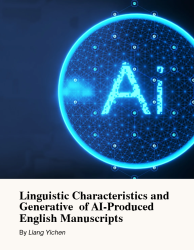Linguistic Characteristics and Generative Mechanisms of AI-Produced English Manuscripts
关键词:
AI writing; English manuscripts; linguistic analysis; generative models; discourse patterns概要
The widespread adoption of artificial intelligence in writing tasks has significantly transformed the production, structure, and stylistic presentation of English manuscripts across academic, educational, and professional domains. As large language models become increasingly sophisticated, their outputs resemble human-produced texts while simultaneously displaying distinct linguistic characteristics shaped by computational prediction rather than human cognition. This book provides a systematic investigation into the linguistic features and generative mechanisms underlying AI-produced English manuscripts. By synthesizing research from computational linguistics, writing studies, and artificial intelligence, the study aims to clarify how AI systems construct meaning, regulate textual coherence, and perform rhetorical functions.
The analysis begins with an examination of surface-level linguistic features such as lexical choice, syntactic complexity, cohesion devices, and semantic consistency. The findings indicate that AI-generated texts often possess high fluency and grammatical accuracy, reflecting the model’s ability to generalize linguistic patterns from extensive training corpora. However, these texts also exhibit identifiable tendencies, including repetitive lexical structures, statistically safe phrasings, and limited idiomatic variation. Such patterns suggest that AI systems optimize for clarity and predictability rather than stylistic richness or authorial voice, resulting in texts that appear polished yet sometimes lack depth and nuance. These stylistic tendencies highlight the statistical nature of AI language modeling and its reliance on probability rather than intention.
At the discourse level, the study explores how AI texts organize arguments, integrate evidence, and construct coherence across paragraphs. Through comparative corpus analysis, it becomes evident that AI-generated manuscripts tend to adopt balanced, neutral, and generalized argumentative structures, often avoiding strong evaluative positions. This rhetorical pattern stems from alignment training, which promotes cautious and non-controversial output. Moreover, AI models may produce vague references, generalized claims, or fabricated sources—artifacts arising from attempts to mimic academic conventions without access to verified domain-specific data. These findings demonstrate both the potential and limitations of AI-generated discourse, emphasizing the importance of human oversight in academic contexts.
The book further investigates generative mechanisms, explaining how AI models rely on probabilistic token prediction rather than semantic understanding. By analyzing training methodologies, alignment processes, and decoding strategies, the study reveals how AI systems simulate human-like discourse while lacking intentional thought. This mechanistic framework accounts for both the strengths—precision, fluency, structural coherence—and the weaknesses—shallow reasoning, occasional semantic drift, lack of originality—of AI-produced English manuscripts. Understanding these mechanisms allows users to more effectively evaluate and refine AI-generated content.
Finally, the research assesses the implications of AI-generated English manuscripts for writing education, academic integrity, and knowledge production. As AI writing tools become more pervasive, there is an urgent need for pedagogical frameworks that help users critically interpret and responsibly use AI-generated texts. The book argues that AI can serve as a powerful assistive tool but must be integrated into writing practice with transparency, critical literacy, and ethical awareness. It also emphasizes developing strategies to differentiate original human work from AI-generated content where necessary, ensuring fairness and academic rigor.
Overall, this study provides a comprehensive analysis of the linguistic, rhetorical, and technological aspects of AI-produced English manuscripts. It contributes to ongoing discussions about the future of writing in an AI-augmented world and offers valuable insights for educators, researchers, and professional writers.











